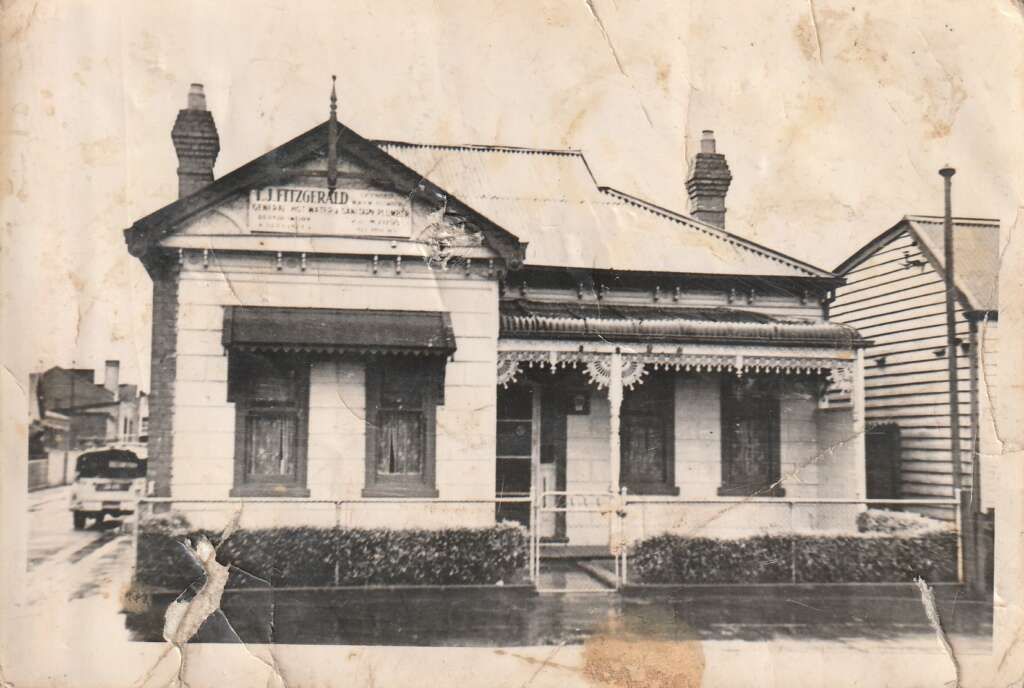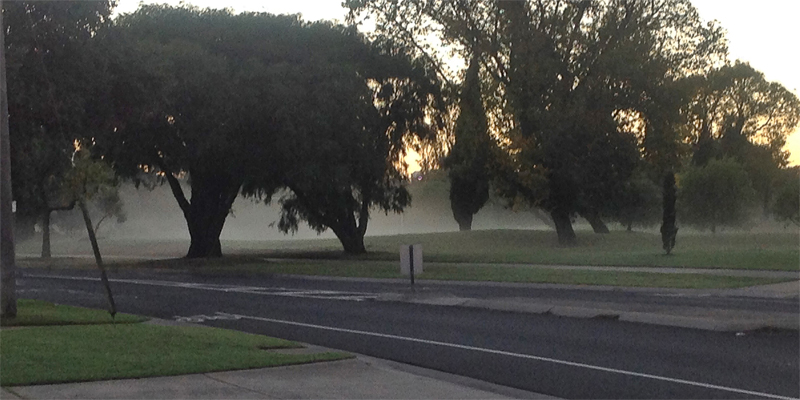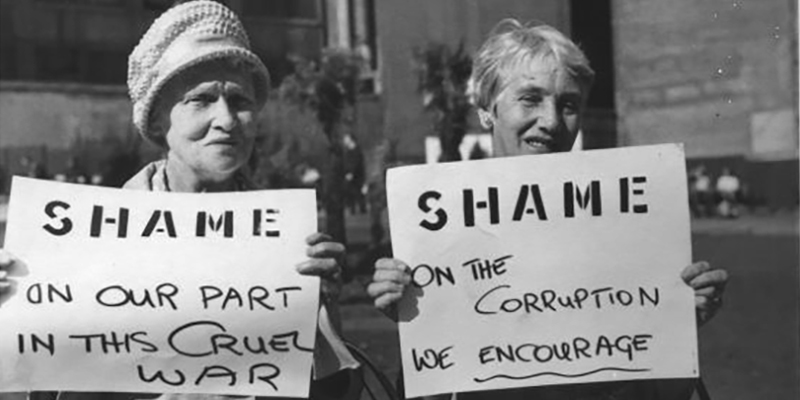The “Worst Hovel in the Municipality”
by David Thompson
At Port Melbourne Council on Tuesday, 13 Oct 1942, the Mayor, Cr Tom Griffin described the North Port Police Station as the “worst hovel in the municipality” adding “the building is a disgrace to Port Melbourne”.[1]
There had been a North Port Police Station as an off-shoot of the main station in Bay Street since the early 1890s. Initially it was on the south side of Farrell Street between Ross Street and Evans Street until about WWI[2] and then it moved around the corner to 123 Ross Street for a few years.[3] In the 1923 Sands and McDougall directory the station is listed at 77 Ross Street on the corner of Clay Street.[4] It was this police station that, almost two decades later, Cr Griffin described as “a hovel”. And that was not the first time he had spoken out in the Council Chamber about the state of the North Port Police Station.
In November of the previous year, not the Mayor at this stage, Cr Griffin described the station as “not fit to house a dog” and moved that the matter be referred to the Police Department with a request for prompt action to provide decent quarters. In discussing the motion, Cr G A Rogers indicated he was well informed that the Department intended to build a new North Port Station in the near future, but Cr M T Woodruff countered that there was some doubt when the new station would be provided. The motion was passed.[5]
Responding to Council, the Under-Secretary advised that with the expansion of residential and industrial properties in the area the station might be moved to a more central location and consequently it was not worth spending money on the current station.[6]
Clearly there was no improvement in the situation when Mayor Griffin made his “hovel” comment and it caught the attention of the metropolitan papers with The Herald describing the North Port Police Station thus.
“The station, a converted brick stable approximately 10ft by 10ft, is headquarters for four policemen. The roof leaks and the building lacks ample light and ventilation. There are no sanitary conveniences. Space is so congested that on washing day police and visitors have to push aside the washing as they step beneath the clothesline to enter the station.”[7]
The article continues.
“The quarters for the resident police officer are almost as bad. The flooring has fallen in, the roof leaks and crumbling plaster is held back by strips of paper pasted over gaping holes.”[8]
Sadly, the photograph accompanying the article is too indistinct to reproduce here.
Cr Griffin was not exaggerating with his pronouncements! Piecing things together we can assume that the resident officer lived in the house at the front of the block, presumably with his family, and the other officers worked out of the small rundown converted stable (approximately 3m x 3m) out the back.
The following day The Herald reported the good news that plans for a new police station and lock-up were being prepared for a site in Williamstown Road near the Fire Station.[9]
Perhaps in a bid to keep the Government representatives honest, local MP, T Corrigan MLA made sure that the condition of the station was mentioned in Parliament and subsequently recorded in Hansard.[10]
As summer progressed, the promise of a new station did not eventuate. The Record reported in January 1943 that during periodical heat waves, the station was move like a baker’s oven. “The only ventilation … is from the door, and a single window, both screened by ARP brickwork protection.”[11]
By March, the good news seems to have turned bad. The North Port Police Station would be closed and the new station would not be built. North Port could be covered by the main Port Melbourne Police Station in Bay Street.[12]
As rumours of the closure circulated around the area the concerns of citizens were presented to Council by Cr Woodruff. Cr Griffin responded saying he had heard the rumour, but he thought the station would still be replaced and vowed to pursue the matter further.[13]
At Council on 30 March, Cr Griffin reported the final deathknell for the North Port Police Station. It would close and the men transferred to the Bay Street station.[14]
Two years later Cr Griffin said at Council that the lack of a police station in North Port was an issue and police protection in the area was not adequate.[15] Still, North Port did not get a new police station and in more recent times even the Bay Street station was closed. It now serves as offices for McClusky’s Lawyers leaving Port without a police station at all.
But what happened to the “worst hovel in the Municipality”? The answer came to us via an enquiry about an item in our collection – an invoice from Port Melbourne plumber T J Fitzgerald (Cat No 528).
Thomas Joseph Fitzgerald’s daughter, Pam Brown, contacted us regarding the invoice and was able to fill in some details regarding the family. At the time the invoice was issued in 1950, Fitzgerald was working out of his parent’s house at 12 Poolman Street. Then after marrying Joyce Stone in 1952, they bought 77 Ross Street, clearly no longer a hovel. Thomas ran his business from the house until he passed away in 1967.
Pam sent the Society this photograph of 77 Ross Street complete with a sign advertising her father’s business. She also said that she had heard that the house was a former police station with stables out the back which prompted us to discover this incredible story. Thank you, Pam.
A double-storey residence now occupies the site at 77 Ross Street on the corner of Clay Street.
[1] 1942 ‘”WORST HOVEL IN THE MUNICIPALITY”‘, Record (Emerald Hill, Vic. : 1881 – 1954), 17 October, p. 1. , viewed 21 Nov 2023, http://nla.gov.au/nla.news-article164970692
[2] 2005 “117 Farrell Street”, History of a Street Precinct, PMHPS, viewed 21 Nov 2023, https://www.pmhps.org.au/street-precinct/farrell117.htm#
[3] 1920 Sands & McDougall’s directory of Victoria : 1920. Melbourne: Sands & McDougall.
[4] 1923 Sands & McDougall’s directory of Victoria : 1923. Melbourne: Sands & McDougall.
[5] 1941 ‘NORTH-PORT NOT PROUD OF POLICE STATION’, Record (Emerald Hill, Vic. : 1881 – 1954), 15 November, p. 4. , viewed 21 Nov 2023, http://nla.gov.au/nla.news-article164974948
[6] 1941 ‘PORT MELB. COUNCIL’, Record (Emerald Hill, Vic. : 1881 – 1954), 13 December, p. 4. , viewed 21 Nov 2023, http://nla.gov.au/nla.news-article164976332
[7] 1942 ‘POLICE STATION CALLED HOVEL’, The Herald (Melbourne, Vic. : 1861 – 1954), 14 October, p. 5. , viewed 21 Nov 2023, http://nla.gov.au/nla.news-article245124765
[8] Ibid
[9] 1942 ‘NEW POLICE STATION FOR NORTH PORT’, The Herald (Melbourne, Vic. : 1861 – 1954), 15 October, p. 5. , viewed 21 Nov 2023, http://nla.gov.au/nla.news-article245127473
[10] 1942 ‘Port Melbourne Council’, Record (Emerald Hill, Vic. : 1881 – 1954), 31 October, p. 4. , viewed 21 Nov 2023, http://nla.gov.au/nla.news-article164981929
[11] 1943 ‘POLICE STATION IS NOT NORTH-PORT’S PRIDE’, Record (Emerald Hill, Vic. : 1881 – 1954), 9 January, p. 1. , viewed 21 Nov 2023, http://nla.gov.au/nla.news-article164975947
[12] 1943 ‘MUNICIPALITY’S “WORST HOVEL” TO CLOSE’, Record (Emerald Hill, Vic. : 1881 – 1954), 13 March, p. 1. , viewed 21 Nov 2023, http://nla.gov.au/nla.news-article164972615
[13] 1943 ‘REPORTED ABOLITION OF POLICE STATION’, Record (Emerald Hill, Vic. : 1881 – 1954), 20 March, p. 2. , viewed 21 Nov 2023, http://nla.gov.au/nla.news-article164977879
[14] 1943 ‘ABOLITION OF NORTH-PORT POLICE STATION’, Record (Emerald Hill, Vic. : 1881 – 1954), 3 April, p. 3. , viewed 21 Nov 2023, http://nla.gov.au/nla.news-article164972431
[15] 1945 ‘Port Melb. Council’, Record (Emerald Hill, Vic. : 1881 – 1954), 23 June, p. 2. , viewed 21 Nov 2023, http://nla.gov.au/nla.news-article165034619



